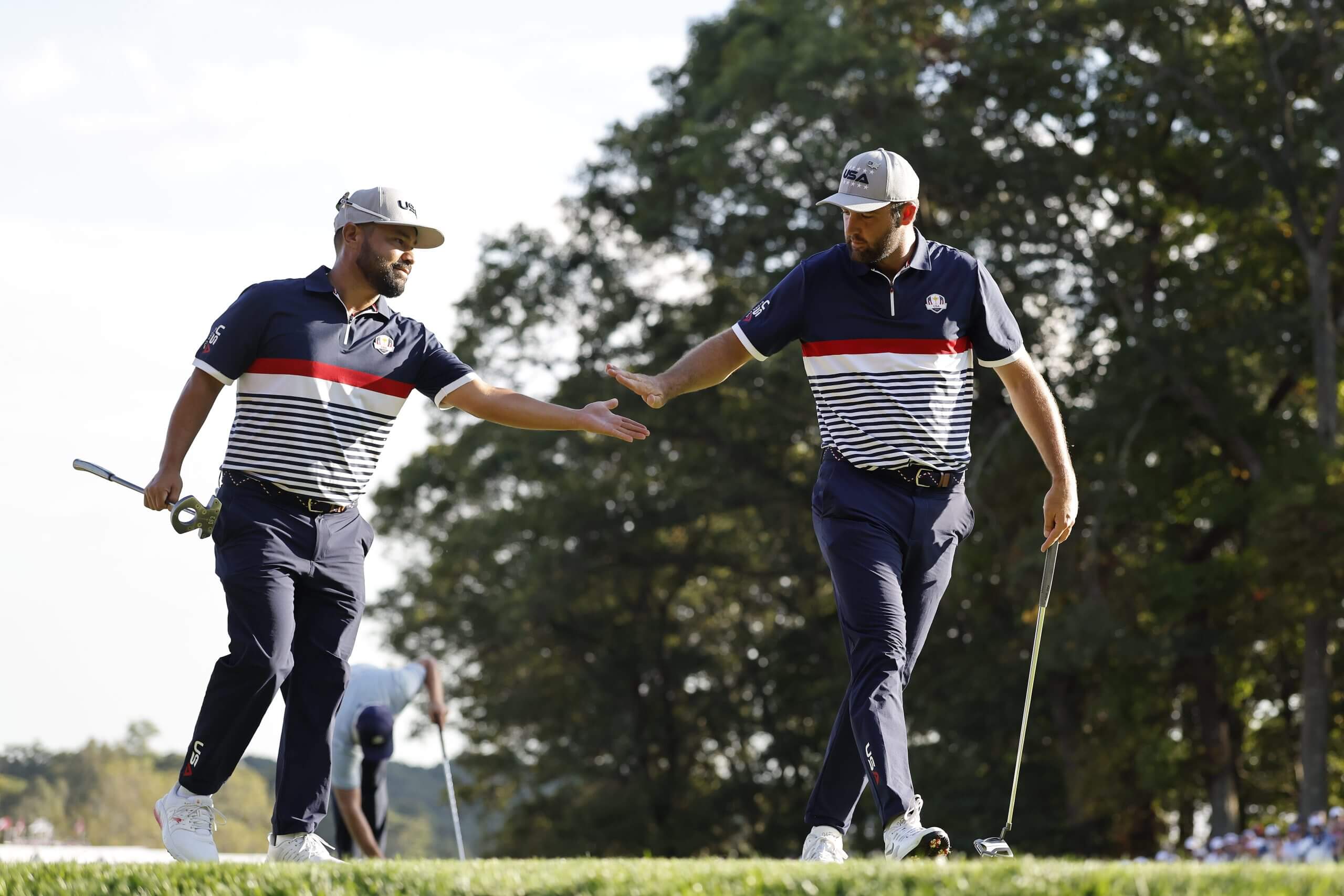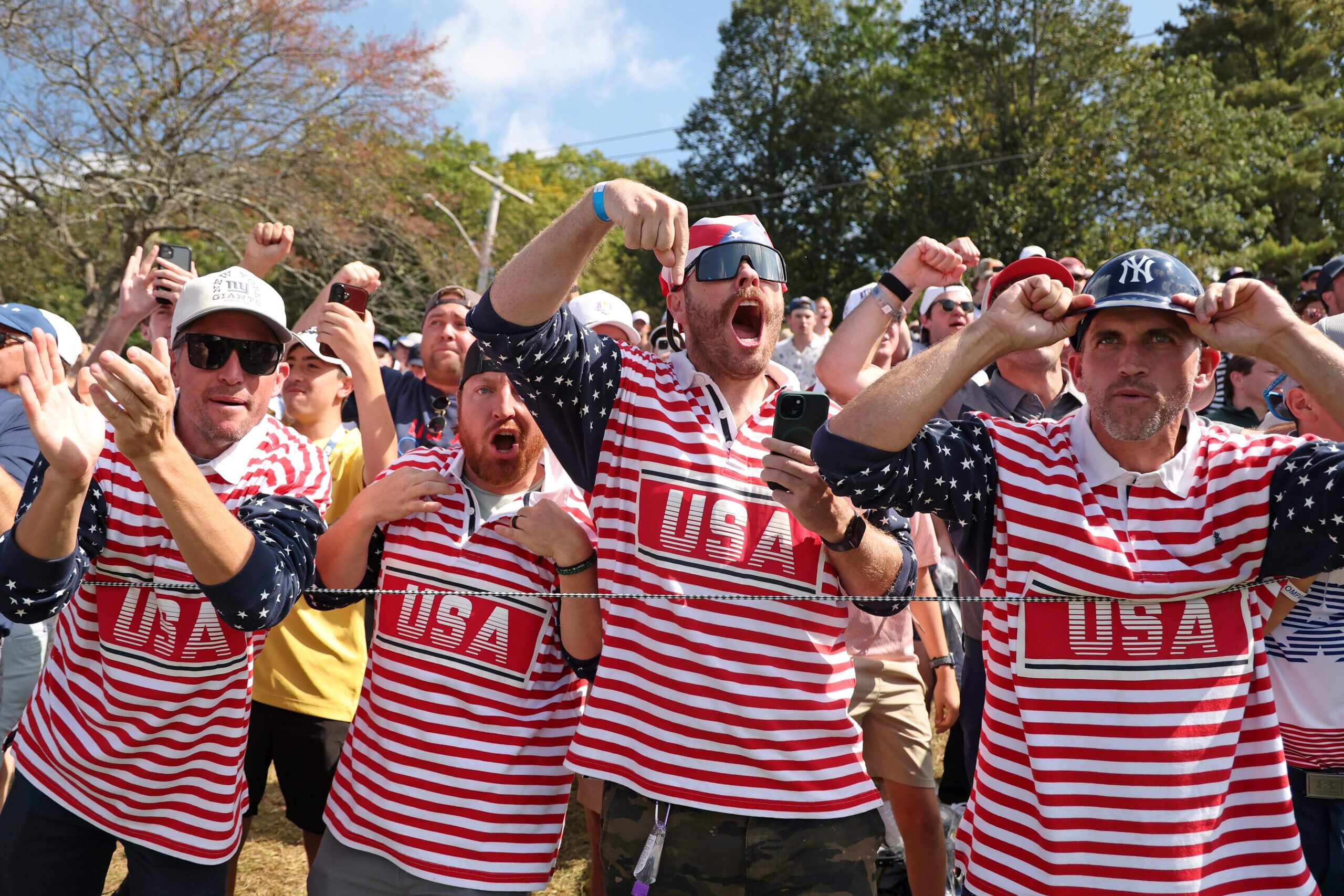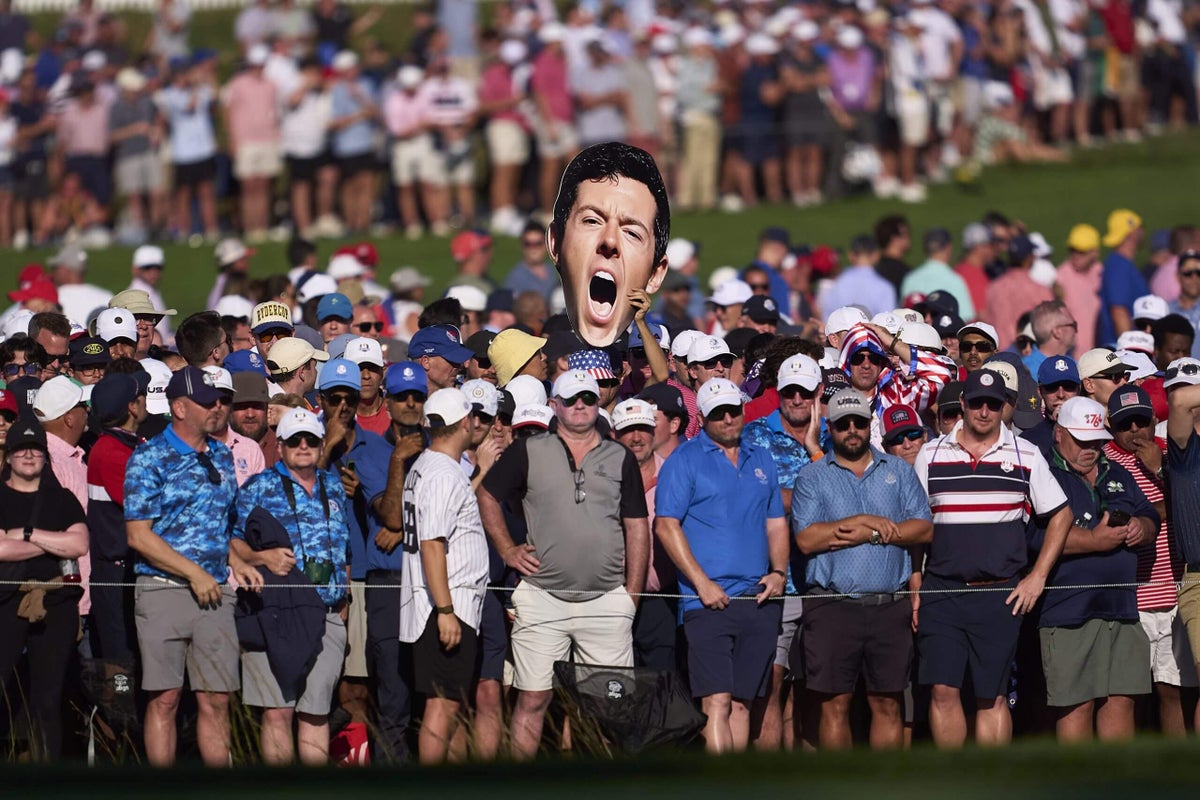We walked towards the dappled shade for a brief relief from the sun and the heat of intense battle at the Ryder Cup.
A friend and I were on our way to the grandstand behind the 14th green at Bethpage Black to watch the fourball matchups on the second day, across a road that splits the course and near a fire engine with a gigantic American flag suspended from its main ladder. Patriotism was here in all its forms.
We were adrift of the biggest swells of crowds as we neared some trees, yet there were still hundreds of fans milling around, discussing where to best see the drama unfold as Europe stood on the cusp of glory heading into the singles matches Sunday. We were away from the fairways and the police state troopers who by then circulated the course after flashpoints of abuse towards players. Quickly, we saw firsthand why they were there.
A U.S. fan, dressed in white and covered in star-spangled banners, was striding past us ahead of a large group, a beer in hand. He saw the European scarf my friend was wearing and shouted at us:
“F— you, Europe!”
The heat was there before the sunrise had opened the showdown. On the first tee about an hour before the 7:10 a.m. ET start of play on Friday, U.S. captain Keegan Bradley whipped up the crowd under the floodlights. “Let’s f—— go, boys,” he said into a microphone.
It was around this time we heard the first profane chants directed at Rory McIlroy, which proved to be among the crowd’s favorite refrains.
This always was the plan. For the U.S. team to lean into home advantage, to harness the home supporters in a bid to win back the trophy they had surrendered in Rome two years earlier. The Europeans, and captain Luke Donald, knew it was coming. They used virtual reality headsets loaded with abuse to prepare. How, exactly? “You don’t want to know,” McIlroy said before the event.
It proved useful. Robert MacIntyre was later targeted on that first tee. Individuals, during quiet moments, shouted: “Hope you have your biscuits in your bag, Bobby!” And: “Bobby, you are a big, big problem!” And: “Bobby Snack-Intyre!”
Still, the masses stuck largely with the go-to chants of both teams. Shouts of “U-S-A, U-S-A” and “Ole, Ole, Ole” were traded, with the home chants inevitably drowning out those of the Europeans. But this is normal, this is expected, this is why it is so hard to win a Ryder Cup as the away team.
Our welcome in New York was warm. Before the event, we were approached by a man at Penn Station in Manhattan, where trains headed out to the state park on Long Island with the course. He plays Bethpage Black, he told us, but only when his driver is “hot.” He said we should watch out for the greens; they are not as tricky as you might expect. There would be a lot of birdies and players should not over-read their putts. How right he was.
Then there was the man who, during the chaos on the 14th green on the second day, gave me his cheat sheet on how to play the course if I was ever in the area again. I asked him why cursing at McIlroy was so prevalent. He was not a fan of “smug” Rory, he said. Others I asked said it was a sign of respect, trying to distract Europe’s talisman.
There were many compliments for the Europeans, too. “The European team is teaching us a lesson,” said one U.S. fan on the sixth fairway on the second day. Another thought: “Why are your songs so much better than ours?” (A history steeped in soccer helps.)
Yet one incident summed up how some people went against that grain. As Scottie Scheffler and J.J. Spaun approached the 15th green in their afternoon fourball on the first day, the sun blazing as it had been for hours, two sturdy men directly in front of us in the grandstand stood up and folded their arms. They were the only two there on their feet. U.S. fans in the rows behind them were not amused.
“Down in front!” came the first shout. “No, you stand up,” came the loud reply, punctuated by the profane line Bradley used to whip up the crowd. “Come on guys, we’ve been here for hours, some people have kids back here,” another fan protested.
So as Scheffler sank a birdie and John Rahm thrillingly replied in similar fashion, some fans could not see the action.
The course’s main grandstand held about 5,000 people and spanned the first tee and the 18th green. Most of the others saw queues to get in because of their limited space. That meant that most spectators had two choices: try to follow a group in the heat and hope for a good view on each part of the course; or get a few holes ahead at a grandstand and watch all the players come through, while viewing the rest on a nearby big screen showing the rest of the action. Both options meant navigating some stubborn supporters.

What we might have seen: J.J. Spaun and Scottie Scheffler on the 15th green on Friday afternoon. (Michael Reaves/PGA of America/PGA of America via Getty Images)
Scheffler, the world No. 1 playing for the United States, was the subject of calls from behind the ropes across his miserable first two days as he lost every match. “Wake up, Scottie!” “Do something, Scottie!” Chants against individual players and not for teams increased in turn.
The toxicity from certain fans gradually increased as the foursome matches were replaced by fourball showdowns in the afternoons. On the second day, at the grandstand behind the 14th green, it became clear something was wrong when warnings about “spectator etiquette” began to flash up on the screens.
Then came McIlroy, closely followed by the chant he seemingly could not escape, which was parroted by the emcee on the first tee. The Northern Irishman had an outpouring of emotion when he sank a birdie to take him and Shane Lowry to one up, walking to the edge of the green past a single state trooper, one of many used to mitigate the situation.
To their credit, organizers had started to increase security and even ejected people when the abuse — homophobic remarks, comments about appearance and family members — for the players became too much.

(Photo: Michael Reaves/PGA of America/PGA of America via Getty Images)Large groups of American men dominated the course. Plenty had clearly been drinking, with beers costing about $40 for a pair, including a tip.
U.S. supporters switched between their U-S-A chant and a staccato “I believe that we can win” number on the first day, with periods of silence increasingly noticeable heading into the singles. Europeans cycled through their repertoire when they got the chance: “You’ve only got one song” and the player-based one-liners, including my favorite: “Here comes the Hotstepper Sepp Straka.”
The way the European team played meant there were relatively few eruptions of cheers during the first two days from U.S. fans, so it was not as intimidating as it could have been. Some of the abuse that came later, though, was disgusting. So it was hard not to feel proud of the way the European team seemed to get better as the treatment worsened.
Those in glass houses should not throw stones, of course. Europeans cannot claim a higher moral ground when it comes to heckling and abuse, given the scenes in soccer in recent years with tragedy chanting and racism, among other unsavory moments.
In golf, the problem does not appear to be as widespread. The Ryder Cup, too, stirs intense concentrations of emotion given the team format.
European supporters were not faultless. There was inevitable goading of some players, gloating after two days when a historic lead had been opened up, and eventual victory. There were some bad winners amid some sore losers. But a line was crossed when the European players and families were targeted with personal abuse and heckled while trying to take their shots, leaving former U.S. captain Tom Watson “ashamed.”
As McIlroy said: “I think golf should be held to a higher standard than what was seen out there this week. Golf has the ability to unite people. Golf teaches you very good life lessons. It teaches you etiquette. … It was a rough week for all of us.”
(Top photo: Mateo Villalba/Getty Images)







